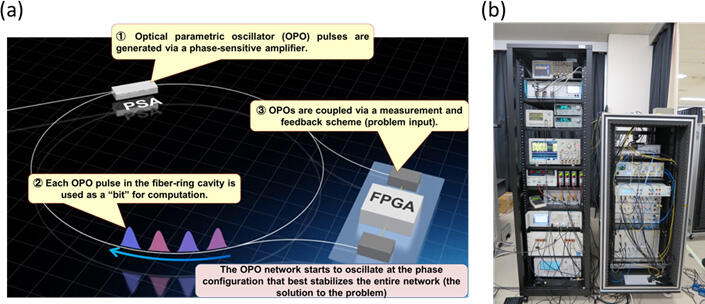Microsoft ends support for Internet Explorer on June 16, 2022.
We recommend using one of the browsers listed below.
- Microsoft Edge(Latest version)
- Mozilla Firefox(Latest version)
- Google Chrome(Latest version)
- Apple Safari(Latest version)
Please contact your browser provider for download and installation instructions.
November 20, 2017
Nippon Telegraph and Telephone Corporation
National Institute of Informatics
The University of Tokyo
Quantum Neural Network on Cloud
Nippon Telegraph and Telephone Corporation (NTT), the National Institute of Informatics (NII), and the University of Tokyo will open a Quantum Neural Network (QNN), a new computer utilizing the quantum nature of light, to the public as an online cloud service.
As the systems and networks in our society, such as the internet, wireless communications networks, and traffic systems, continue to increase in scale and complexity, their optimization is becoming increasingly important. The QNN uses the quantum characteristics of a new type of laser, called an optical parametric oscillator (OPO), to find solutions to combinatorial optimization problems instantly. The research team constructed a cloud system that enables access to the QNN system through the internet from all over the world. With this QNN cloud system, users can experience the extremely rapid computation of large-scale optimization problems. The team expects the QNN cloud system to accelerate the research and development of QNN applications. The project is a collaborative effort with Osaka University.
Quantum Neural Network (QNN)
Figure 1 (a) is a schematic of the setup of the QNN, which is based on an optical fiber cavity comprising a 1-km-long optical fiber and an optical phase-sensitive amplifier (PSA). Thousands of pulsed OPOs, generated by switching the PSA on and off at gigahertz frequencies, travel in the cavity. Interactions among the OPO pulses are adjusted according to a given optimization problem. After the OPO pulses make several circulations in the cavity, their phase configuration tends to reach the best possible combination for stabilizing the entire OPO network. The phase configuration corresponds to a solution to the optimization problem. Since arbitrary pairs among 2,000 OPOs can be constructed via a measurement and feedback scheme, the QNN can find solutions to 2,000-node combinatorial optimization problems in a very short time.
In our previous research, the QNN was constructed on a large table as a proof-of-principle experimental setup. We have now developed a rack-mountable QNN system for the cloud service (Fig. 1 (b)). By improving the phase stabilization of the optical circuit and implementing precise temperature control of the 1-km-long optical fiber cavity, we have achieved continuous operation of the QNN for more than one week.

QNN Cloud system for computation experience
We will open the QNN system to the public so that users around the world can experience its computational capabilities. The QNN Cloud system consists of a web application server managed by NII and the QNN system located at NTT Basic Research Laboratories. The system enables general users with no expertise in complex optical experiments to experience QNN computation. In the first release, users can find solutions to large-scale maximum-cut problems on complete (all-to-all) graphs with up to as many as 2,000 nodes.
Link to the QNN Cloud system
Information is current as of the date of issue of the individual press release.
Please be advised that information may be outdated after that point.
NTT STORY
WEB media that thinks about the future with NTT










